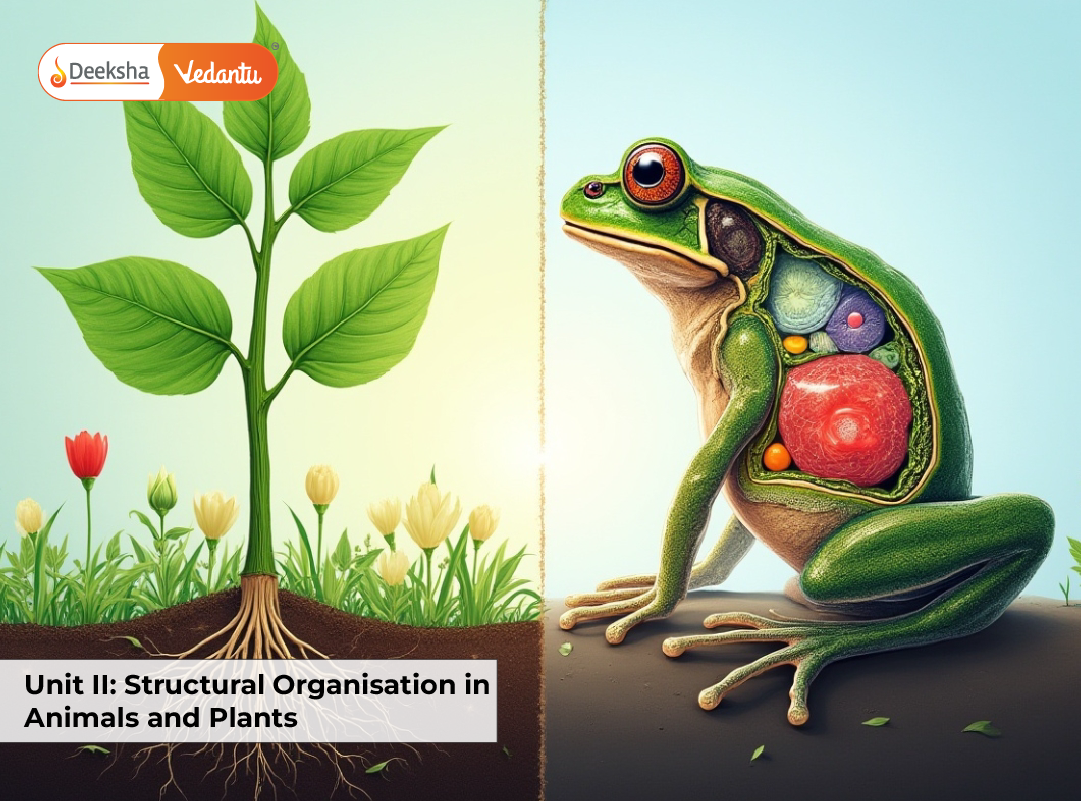After understanding the vast diversity of life forms in Unit I Biology, Unit II Biology of Class 11 NCERT introduces us to how plants and animals are organized structurally. The focus is on the internal architecture of multicellular organisms, especially the organization of tissues, organs, and organ systems.
For NEET aspirants, this unit forms a foundational understanding of structural biology and includes several frequently asked questions. With conceptual clarity, visual memory, and comparative analysis, this unit can significantly boost your NEET Biology score.
Before we explore the specifics, it’s important to understand the central theme of Unit II Biology– Structural Organisation in Animals and Plants. This unit begins with the detailed morphology of flowering plants: their external structures like roots, stems, leaves, flowers, fruits, and seeds, all of which play critical roles in plant life cycles and taxonomy. The NCERT text emphasizes various types of roots (tap, fibrous), stems (herbaceous, woody), leaf arrangements, and reproductive structures, laying a foundational understanding of plant identification. Likewise, in animals, it introduces how cells organize into tissues, and tissues into complex organs and organ systems—explored further in later chapters.
What Does Unit II Biology Cover?
Unit II Biology comprises three main chapters:
- Chapter 5: Morphology of Flowering Plants – This chapter covers the external structures of angiosperms, starting from the types and modifications of roots, stems, and leaves. It also explains various forms of inflorescence, detailed floral structures, types of flowers, fruits (simple, aggregate, multiple), and seeds. Special attention is given to floral formulas and diagrams, which are important for NEET-based plant family identification.
- Learn various types of roots: tap root, fibrous root, adventitious root.
- Understand stem and leaf modifications for storage, climbing, and defense.
- Focus on flower structure, symmetry, ovary position, and aestivation patterns.
- Familiarize with key plant families like Fabaceae, Solanaceae, and Liliaceae with floral formulas.
- Chapter 6: Anatomy of Flowering Plants – Here, we study the internal anatomy of plants including meristematic and permanent tissues, vascular bundles, and secondary growth in dicots. Students are expected to distinguish between monocot and dicot roots, stems, and leaves with the help of transverse sections and labeled diagrams, often featured in NEET.
- Revise tissue types: parenchyma, collenchyma, sclerenchyma, xylem, and phloem.
- Understand primary and secondary growth, cambium activity, and annual rings.
- Identify monocot vs dicot anatomy via labelled transverse sections (T.S.).
- Chapter 7: Structural Organisation in Animals – This chapter begins with the four basic types of animal tissues (epithelial, connective, muscular, and nervous), followed by the organ and organ system level of organization. Case studies of earthworm, cockroach, and frog give a complete overview of anatomical features in invertebrates and lower vertebrates, commonly tested in NEET MCQs.
- Focus on structure, types, and functions of animal tissues.
- Study cockroach segmentation and digestive system—frequently asked in NEET.
- Memorize the body structure and reproductive systems of earthworm and frog.
These chapters emphasize form and function relationships, helping students understand how structural adaptations support physiological roles in both plants and animals.
NEET Relevance of Unit II Biology
- NEET Weightage Insight: Historically, Unit II Biology contributes approximately 8–10% of the total NEET Biology section, which translates to around 7 to 10 marks out of 90. This makes it essential to prepare each chapter thoroughly. The questions are typically fact-based and directly picked from NCERT content, especially from well-labeled diagrams and tabular data.
- High-yield Chapters: Anatomy and morphology questions frequently appear in NEET due to their factual and diagram-based nature.
- Image-based Questions: Diagrams from NCERT on tissues, plant structures, and animal histology are often used in NEET.
- Conceptual Understanding: The types of tissues (parenchyma, collenchyma, sclerenchyma in plants and epithelial, connective, muscular, and nervous tissues in animals) are critical for MCQs.
- Comparative Analysis: NEET often tests differences between monocot and dicot anatomy or simple vs compound tissues.
How to Study Unit II Biology for NEET
- Focus on NCERT diagrams and label them multiple times. Visual learning is crucial for retention. Diagrams related to plant tissues, root/stem/leaf anatomy, and animal histology often appear as direct questions.
- Create summary charts for tissue types and their locations. These charts help quickly revise important structures, differences, and examples that are frequently asked in NEET.
- Practice previous year NEET MCQs on morphology and animal tissues. This helps understand the exam pattern, commonly asked questions, and identify your weak areas.
- Use flowcharts and tables to revise plant and animal anatomy. Organizing information this way improves recall, especially when comparing monocot vs dicot anatomy or different animal tissue types.
- Supplement your preparation with flashcards and mnemonics for structures and functions, particularly useful for memorizing plant families, floral formulas, and body parts of organisms like earthworm, cockroach, and frog.
Frequently Asked Questions (FAQs)
1. How important is Unit II Biology for NEET?
Unit II Biology is highly significant, contributing approximately 7 to 10 marks in NEET Biology. Its chapters are factual and concept-driven, which makes them ideal for quick scoring when thoroughly prepared from the NCERT textbook.
2. Which chapters in Unit II Biology carry the highest weightage?
Chapters 5 and 7—Morphology of Flowering Plants and Structural Organisation in Animals—tend to carry the most weight in NEET. These sections include many direct NCERT-based questions.
3. Are diagrams from NCERT sufficient for NEET preparation?
Yes, NCERT diagrams are not only sufficient but also essential. Questions based on exact NCERT figures frequently appear in NEET, especially plant tissues, floral diagrams, and cross-sections of plant parts.
4. What’s the best way to memorize plant families and their floral formulas?
Use flashcards and mnemonic techniques to remember key characteristics of families like Fabaceae, Solanaceae, and Liliaceae. Practice drawing floral diagrams repeatedly.
5. How can I differentiate animal tissue types effectively?
Create comparison tables outlining the features, functions, and locations of different animal tissues. This helps in quick revision and better retention for NEET MCQs.
Conclusion
Unit II Biology of Class 11 —Structural Organisation in Animals and Plants—lays the groundwork for understanding the form and function of life at the tissue and organ system levels. With consistent NCERT-based preparation, visual memory through diagrams, and strategic MCQ practice, this unit can substantially contribute to your NEET score. Whether it’s mastering the intricate anatomy of plant stems or recognizing the histology of animal tissues, this unit is both scoring and essential. Now, let’s move ahead into Chapter 5 and dive deeper into the morphology of flowering plants for NEET.




Get Social